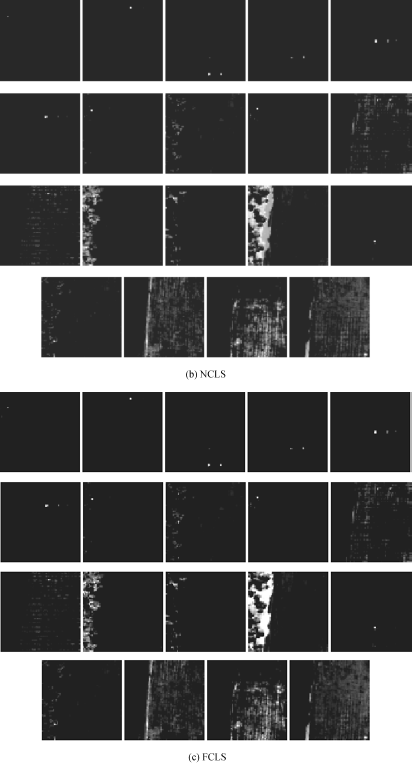17.5 Real-Image Experiments
The HYDICE image scene in Figure 1.15 was chosen for real-image experiments because the ground truth of 15 panels specified by 19 R pixels is completely available for LSMA performance evaluation. Nevertheless, this ground truth should be only used to serve a reference since the scene is real data where uncharacterized spectral variations may affect the performance. Specifically, those pixels that are identified by a ground crew as panel center pixels may not actually pure pixels as demonstrated by Chang et al. (2004) and will be also shown in the following experiments. These experiments indicate that the prior knowledge may not be as reliable as it is supposed to be.
17.5.1 LS-ULSMA
First of all, the VD estimated for this scene, nVD, is 9 with the false alarm probability ![]() . Figure 17.12(a) shows the 9 target VSs that were extracted directly from the original data by the ATGP and were considered as a set of BKG VSs
. Figure 17.12(a) shows the 9 target VSs that were extracted directly from the original data by the ATGP and were considered as a set of BKG VSs ![]() that included three panel pixels from rows 1, 3, and 5. Figure 17.12(b) shows the 9 target VSs extracted from the sphered data by ATGP that included five panel panels extracted from each of five rows and were considered as a set of target VSs,
that included three panel pixels from rows 1, 3, and 5. Figure 17.12(b) shows the 9 target VSs extracted from the sphered data by ATGP that included five panel panels extracted from each of five rows and were considered as a set of target VSs, ![]() . Figure 17.12(c) singles out the five VSs that were identified as BKG VSs,
. Figure 17.12(c) singles out the five VSs that were identified as BKG VSs, ![]() by removing the four target VSs using a similarity measure such as SAM, and Figure 17.12(d) shows a total number of 14 VSs obtained by combining the BKG VS set
by removing the four target VSs using a similarity measure such as SAM, and Figure 17.12(d) shows a total number of 14 VSs obtained by combining the BKG VS set ![]() in Figure 17.12(c) with the target VS set
in Figure 17.12(c) with the target VS set ![]() in Figure 17.12(b) into a BKG-target VS merged set
in Figure 17.12(b) into a BKG-target VS merged set ![]() to be used for spectral unmixing where the numbers in the figures indicated the orders of VSs extracted by the ATGP.
to be used for spectral unmixing where the numbers in the figures indicated the orders of VSs extracted by the ATGP.
Figure 17.12 ATGP-generated BKG and target VSs: (a) nine BKG VSs in original data; (b) nine target VSs in sphered data; (c) five BKG VSs not identified as target VSs; (d) 14 VSs obtained by merging the VSs in (b–c).

Similarly, Figures 17.13(d)–17.14(d) also show 14 VSs produced by the UNCLS including nine target VSs and five BKG VSs and 15 VSs extracted by the UFCLS including nine target VSs and six BKG VSs. Since the target VSs of interest were those extracted by the three LS-based algorithms in Figures 17.12(b), 17.13(b), and 17.14(b) from the sphered data they should have included five pure targets VSs that corresponded to all the five pure panel signatures. This was exactly the case where these five pure panel pixels, p11, p221, p312, p411, and p521 were found and identical in Figures 17.12(b), 17.13(b), and 17.14(b). Additionally, among these five pure panel pixels, p11, p312, and p521 were the only three target VSs extracted as BKG VSs in the original data in Figures 17.12(a), 17.13(a), and only two panel pixels p312 and p521 extracted in 17.14(a). This is due to the fact that the panel pixels in rows 2 and 4 have very similar signatures to those in rows 3 and 5, respectively, according to the ground truth in which case they were not extracted as endmembers. Interestingly, these three pure target VSs were the only endmembers extracted by any endmember extraction algorithm except the case when dimensionality reduction is performed by the independent component analysis (ICA) as shown in the following section.
Figure 17.13 UNCLS-generated BKG and target VSs: (a) nine BKG VSs in original data; (b) nine target VSs in sphered data; (c) five BKG VSs not identified as target VSs; (d) 14 VSs obtained by combining the VSs in (b–c).

Figure 17.14 UFCLS-generated BKG and target VSs: (a) nine BKG VSs in original data; (b) nine target VSs in sphered data; (c) six BKG VSs not identified as target VSs; (d) 15 VSs obtained by merging the VSs in (b–c).

In order for LSMA to perform effectively, the targets signatures used to form the signature matrix M must include all the targets VSs ![]() and BKG VSs
and BKG VSs ![]() to represent the entire data where the target VSs
to represent the entire data where the target VSs ![]() are the target signatures we would like to unmix and the BKG VSs
are the target signatures we would like to unmix and the BKG VSs ![]() are considered as undesired signatures that can be suppressed to enhance target classification performance. The three LSMA methods, LSOSP, NCLS, and FCLS, were used to unmix high-order target VSs
are considered as undesired signatures that can be suppressed to enhance target classification performance. The three LSMA methods, LSOSP, NCLS, and FCLS, were used to unmix high-order target VSs ![]() extracted from the sphered data, each of which was considered to represent one specific target class. Figures 17.15(a)–(c) to 17.17(a)–(c) show their corresponding results where figures labeled by (a), (b), and (c) are unmixed results by LSOSP, NCLS, and FCLS, respectively.
extracted from the sphered data, each of which was considered to represent one specific target class. Figures 17.15(a)–(c) to 17.17(a)–(c) show their corresponding results where figures labeled by (a), (b), and (c) are unmixed results by LSOSP, NCLS, and FCLS, respectively.
Figure 17.15 Nine target classes obtained by LSOSP, NCLS, and FCLS using the target pixels generated by ATGP-UVSFA.

Figure 17.16 Nine target classes obtained by LSOSP, NCLS, and FCLS using the target pixels generated by UNCLS-UVSFA.

Figure 17.17 Nine target classes obtained by LSOSP, NCLS, and FCLS using the target pixels generated by UFCLS-UVSFA.

Obviously, the results obtained by NCLS and FCLS performed better than that produced by LSOSP in Figures 17.15–17.17 due to the imposed constraints on abundance fractions. Interestingly, while the results in Figure 17.15(b) and (c) were similar to the results obtained in Figures 17.16(b) and (c) and 17.17(b) and (c), the umixed results obtained by LSOSP in Figure 17.15(a) were slightly better than those in Figures 17.15(a) and 17.16(a) in terms of detection of 15 panels in five rows. This improvement was mainly due to the fact that UFCLS produced six BKG VSs to perform better BKG suppression rather than five BKG VSs produced ATGP and UNCLS. Also, it should be noted that there were of course more BKG pixels that could be used for this purpose. As a matter of fact, in Heinz and Chang (2001) and Chang (2003a, Chapter 5) there were 34 pixels found by the unsupervised FCLS for spectral unmixing. The results were similar to those presented in our experiments using only 9 image endmembers. In this case, “9” is probably sufficiently enough for LSMA to perform spectral unmixing well.
17.5.2 CA-ULSMA
Once again the value of VD was set to p = nVD = 9 for CA-UVSFA to find nine signatures from nine PCs and signatures with maximal and minimal projections in nine ICs. Figure 17.18(a) shows the nine target VSs extracted by maximal IC projection. Figure 17.18(b) shows the nine target VSs extracted by minimal IC projection. Figure 17.18(c) shows the nine BKG VSs extracted by maximal PC projections, and Figure 17.18(d) shows the total 19 VSs obtained by merging signatures in Figure 17.18(a)–(c). The 19 VSs obtained in Figure 17.18(d) are the used as VSs for the signature matrix M to form a linear mixture model and LSOSP, NCLS, and FCLS were implemented to perform unmixing. Figure 17.19(a)–(c) shows their abundance maps of unmixed results, respectively.
Figure 17.18 CA-UTFA results for HYDICE scene: (a) nine IC Max VSs; (b) nine IC Min VSs; (c) nine PC Max VSs; (d) 19 VSs found by merging results in (a)–(c).

Obviously, the unmixed results obtained by NCLS in Figure 17.19(b) and FCLS in Figure 17.19(c) were much better than those obtained by LSOSP in Figure 17.19(a) due to the imposed abundance constraints. Interestingly, the pixels in Figures 17.12(b), 17.3(b), and 17.4(b) found by LS-UVSFA via the sphered data and pixels in Figure 18(a) found by CA-UVSFA via ICA included five identical panel pixels, p11, p221, p312, p411, and p521 that specify five distinct panel signatures. If we assume that these five pixels were the main target signatures of interest and pixels other than target signatures were considered as BKG signatures, then the only differences between these two algorithms was the BKG signature extraction where more BKG signatures were produced by CA-UVSFA than LS-UVSFA for LSMA to perform BKG suppression. The fact that more BKG signatures were used by CA-LSMA for BKG suppression than that by LS-LSMA our visual inspection showed that the unmixed results of panel pixels in five rows in Figure 17.19 by CA-LSMA were more cleaner and clearer than those in Figures 17.15–17.17 unmixed by LS-LSMA. However, did this also imply that CA-LSMA produced more accurate quantification results of 19 R pixels than LS-LSMA? Interestingly, the answer is “not necessarily true.” The following section is included to address this issue.
17.5.3 Qualitative and Quantitative Analyses between ULSMA and SLSMA
Two important factors affect the performance of LSMA: capability in unmixng and ability in BKG suppression. An early development of orthogonal subspace projection (OSP) (Harsanyi and Chang, 1994) was designed for this purpose to make LSMA work more effectively by separating signatures into desired signatures to be considered as target signatures and undesired signatures to be considered as BKG signatures. This concept is further confirmed by ULSMA presented in Sections 17.2 and 17.3. This section further demonstrates that the performance of ULSMA using the designed UVSFA is superior to that of SLSMA using assumed prior signature knowledge in sense of target signature unmixing and BKG suppression.
In order to make SLSMA work more effectively, we must include other BKG signatures in a linear mixing model so that a better BKG suppression can result in a better spectral unmixing. Using full knowledge of the scene by visual inspection and prior knowledge provided by ground truth there were at least three identified BKG signatures, grass, tree, and road shown in Figure 17.20 in addition to 19 center panel pixels marked by red shown in Figure 1.16(b).
Figure 17.20 Areas identified by ground truth and marked by three BKG signatures, grass, tree, and road plus an interferer.

There is an interesting observation in the scene worth noting. It has been shown in many experiments that there was an interferer marked in Figure 17.20 that generally could not be identified by visual inspection or prior knowledge but has very strong energy that can be always extracted by any unsupervised target detection algorithm such as algorithms developed in Chang (2003a). If this interferer signature is included with the five panel signatures in Figure 1.16 and the other three BKG signatures to make up five target classes representing five panel signatures and four BKG classes to form a signature matrix M for spectral unmixing, there are exactly nine signatures estimated by VD. This fact provides further evidence that VD is an effective estimation method to estimate the number of image endmembers for spectral unmixing. However, in order to see if including the interferer in the signature matrix M makes a difference, Figures 17.21(a)–(c) and 17.22(a)–(c) show respective unmixed results of 19 panel pixels via abundance fractional maps produced by three SLSMA methods, LSOSP, NCLS, and FCLS using an 8-signature matrix M = [p1,p2,p3,p4,p5, grass,tree,road] without the interferer and a 9-signature matrix M = [p1,p2,p3,p4,p5, grass,tree,road,interferer], both of which use the five panel signatures in Figure 1.16 to represent p1,p2,p3,p4,p5. Since the BKG classes are not of major interest, the unmixed results for the four BKG classes are not included in the figures.
Comparing the results in Figure 17.22 to that in Figure 17.21, it was apparent that the effect of the interferer was very significant, specifically for LSOSP. If we further compare the results in Figures 17.21–17.22 to Figures 17.15–17.17 and Figure 17.19 it was also clear that ULSMA performed significantly better than its supervised counterpart, SLSMA, in terms of unmixing the 19 R panel pixels, specifically panel pixels in rows 3 and 5. These experiments further demonstrated that SLSMA was not as effective as ULSMA when it came to real data mainly due to the unknown knowledge about the BKG that played a key role in BKG suppression for LSMA.
Figure 17.21 Unmixed results of 15 panels with 19 panel pixels by LSOSP, NCLS, and FCLS using five panel signatures in Figure 1.16 and 3 BKG signatures, grass, tree, and road obtained by marked areas inn Figure 17.20.

Figure 17.22 Unmixed results of 15 panels with 19 panel pixels by LSOSP, NCLS, and FCLS using five panel signatures in Figure 1.16 and 4 BKG signatures, grass, tree, road, and interferer obtained by marked areas in Figure 17.20.
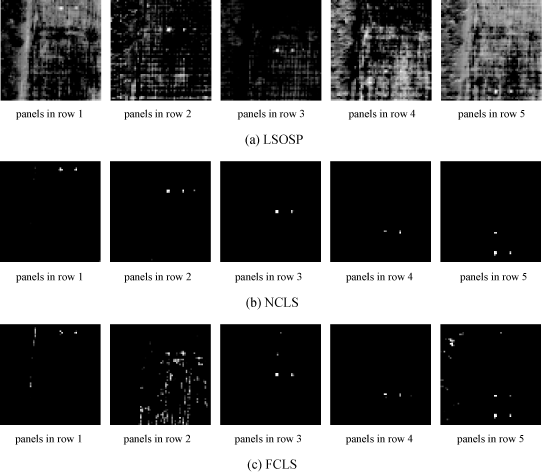
The above unmixed results are evaluated qualitatively by visual assessment. The conclusions may not be objective. So, Table 17.1 further provides quantification results in Figures 17.15–17.17 and tabulates the unmixed abundance fractions of 19 R panel pixels in Figures 17.15–17.17 produced by LSOSP, NCLS, and FCLS using VSs found by the three LS-based UVSFAs, ATGP, UNCLS, and UFCLS. The bottom row in the table calculated the total error for each of methods based on the sum of squared errors between the estimated abundance fractions of 19 R panel pixels and their ground truth provided in the second column. Since the 5 R panel pixels in the third column are subpanel pixels, their ground truth panel abundance fractions were calculated based on the ratio of their size to the pixel size, which is ![]() . According to Table 17.1 the abundance fractions of the 19 R panel pixels estimated by NCLS and FCLS were very close. Surprisingly, the total error resulting from LSOSP was smallest, while FCLS resulted in the largest total errors. This conclusion was completely reversed by visual assessment based on Figures 17.15–17.17. However, if we compare the unixed abundance fractions of the individual 19 R panel pixels against their respective ground truth FCLS was indeed the best compared to LSOSP that was still the worst. This simple example indicated that simple total quantification errors did not provide a complete picture of how effective LSMA may perform. In particular, the quantification errors were only calculated only based on 19 R panel pixels by completly discarding the effect resulting from BKG suppression which can be clearly seen in Figures 17.15–17.17.
. According to Table 17.1 the abundance fractions of the 19 R panel pixels estimated by NCLS and FCLS were very close. Surprisingly, the total error resulting from LSOSP was smallest, while FCLS resulted in the largest total errors. This conclusion was completely reversed by visual assessment based on Figures 17.15–17.17. However, if we compare the unixed abundance fractions of the individual 19 R panel pixels against their respective ground truth FCLS was indeed the best compared to LSOSP that was still the worst. This simple example indicated that simple total quantification errors did not provide a complete picture of how effective LSMA may perform. In particular, the quantification errors were only calculated only based on 19 R panel pixels by completly discarding the effect resulting from BKG suppression which can be clearly seen in Figures 17.15–17.17.
Table 17.1 Estimated abundance fractions of 19 panel pixels produced by LSOSP, NCLS, and FCLS using BKG and target VSs found in Figures 17.15–17.17 by ATGP-UVSFA, UNCLS-UVSFA, and UFCLS-UVSFA.
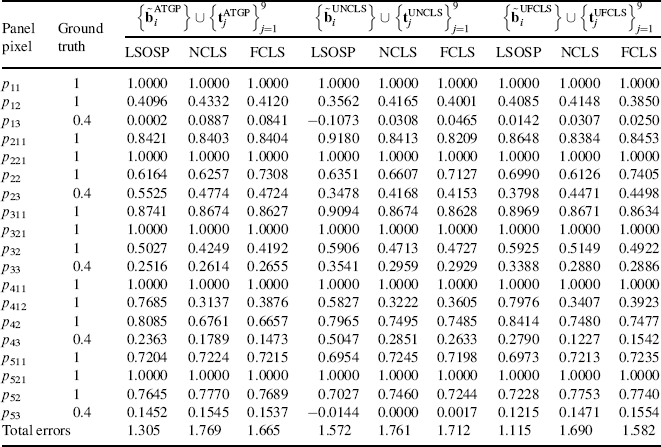
Further, Table 17.2 also tabulates the unmixed abundance fractions of 19 R panel pixels in Figure 17.19(a)–(c) produced by LSOSP, NCLS, and FCLS using VSs found by CA-based UVSFA where the total error for each of methods was calculated based on the sum of squared errors between the unmixed abundance fractions of 19 R panel pixels and their ground truth provided in the second column. The conclusions drawn from this table were the same as what we concluded for Table 17.2 where the total error resulting from LSOSP was smallest compared to the largest total error produced by FCLS. Similarly, FCLS performed generally better than LSOSP if each of the individual 19 R panel pixels is taken into consideration for comparison.
Table 17.2 Quantification results of abundance fractions of 19 panels estimated by CA-ULSMA.

Comparing the results in Table 17.2 to the results in Table 17.1 the experiments suggested that LS-LSMA generally performed a little bit better than CA-LSMA in terms of total error. Specifically, the unmixed abundance fraction of p13 produced by NCLS and FCLS was zero in Table 17.2 as opposed to nonzero unmixed abundance fractions of p13 in Table 17.1.
To compare the quantification results produced in Table 17.1 by LS-ULSMA and Table 17.2 by CA-ULSMA, Table 17.3 also tabulates unmixed abundance fractions of 19 panel pixels in Figures 17.23 and 17.24 produced by SLSMA using prior knowledge provided by Figures 1.16 and 17.20 where each entry in Table 17.3 has two values with the one before and the one after “/” indicating the results produced by using three BKG signatures (grass, tree, and road) and four BKG signatures (grass, tree, road, and interferer), respectively.
Figure 17.23 Abundance fractional maps of 15 panels with 19 panel pixels produced by LSOSP, NCLS, and FCLS using five panel signatures obtained by averaging R panel pixels in the first two columns in Figure 1.15(b) and 3 BKG signatures, grass, tree, and road obtained by marked areas inn Figure 17.20.
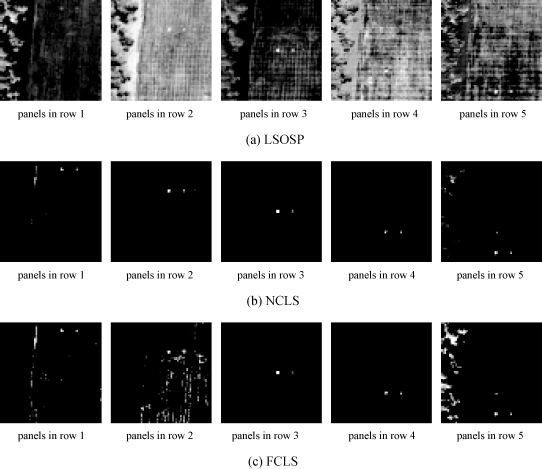
Figure 17.24 Abundance fractional maps of 15 panels with 19 panel pixels produced by LSOSP, NCLS, and FCLS using five panel signatures obtained by averaging R panel pixels in the first two columns in Figure 1.15(b) and 4 BKG signatures, grass, tree, road, and interferer obtained by marked areas inn Figure 17.20.

Table 17.3 Estimated abundance fractions of 19 panel pixels in Figures 17.21–17.22 produced by LSOSP, NCLS, and FCLS using five panel signatures obtained by averaging all R pixels in the first three columns using (three BKG signatures/four BKG signatures)

An interesting finding from Table 17.3 was that the abundance fractions of panel pixels p412 unmixed by NCLS and p411, p412 unmixed by FCLS were 0. This was caused by the fact that the five panel signatures p1, p2, p3, p4, and p5 in Figure 1.16 used for spectral unmixing were not really pure signatures because the panel pixels in the third column that were included for averaging were actually subpixels and not pure signatures. If we repeat the same experiments by using the panel signatures p1, p2, p3, p4, and p5 that were obtained by averaging only R panel center pixels in the first and second columns for spectral unmixing, Figures 17.23 and 17.24 show the unmixed results of the 19 R panel pixels via abundance fractional maps produced by three SLSMA methods, LSOSP, NCLS, and FCLS where the results using four BKG signatures (grass, tree, road, and interferer) obtained by Figure 17.20 were significantly improved compared to that by using three BKG signatures (grass, tree, and road), specifically, LSOSP, and NCLS.
If we compare the results in Figures 17.23 and 17.24 to their counterparts, Figures 17.21 and 17.22, it showed that the best SLSMA result was the one produced by NCLS using R panel pixels in the two first columns and four BKG signatures in Figure 17.24(b). Other than that all the results were comparable. For further quantification comparison, Table 17.4 tabulates unmixed abundance fractions of 19 panel pixels in Figures 17.23 and 17.24 produced by LSOSP, NCLS, and FCLS using five panel signatures obtained by averaging all R pixels in the first two columns in Figure 1.15(b) and three BKG signatures and four BKG signatures, respectively, where each entry in Table 17.4 has two values with the one before and the one after “/” indicating the results produced by using three BKG signatures (grass, tree, and road) and four BKG signatures (grass, tree, road, and interferer), respectively.
Table 17.4 Estimated abundance fractions of 19 panel pixels in Figures 17.23 and 17.24 produced by LSOSP, NCLS, and FCLS using five panel signatures obtained by averaging all R pixels in the first two columns using (three BKG signatures/four BKG signatures)
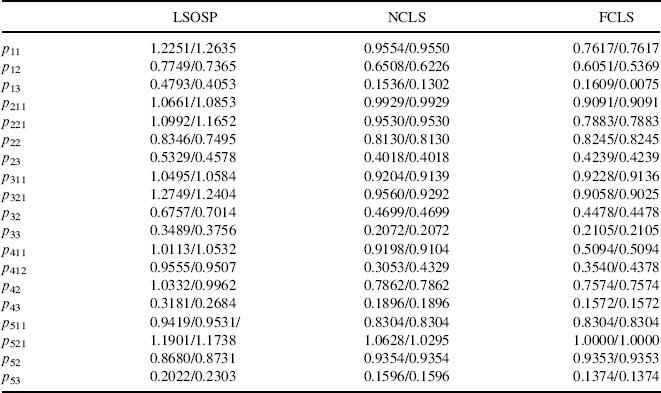
In comparison with Table 17.3 where the FCLS-unmixed abundance fractions of panel pixels p411 and p412 were zeros they were now corrected and no longer 0. Despite that the provided ground truth p411 and p412 were the panel center pixels, from our extensive experience with the HYDICE scene, they were in fact not as pure pixels of 100% abundance purity as we expected. As a result, even though NCLS is partially abundance-constrained, it was very comparable to the fully abundance-constrained FCLS in terms of abundance unmixing. Nevertheless, both performed significantly better than the abundance-unconstrained LSOSP.
Now if we further compare the results in Table 17.4 against that in Table 17.3, it apparently shows that using contaminated or inaccurate prior knowledge may result in significant distortion in quantification of abundance fractions. Furthermore, comparing the results in Tables 17.1 and 17.2 against those in Tables 17.3 and 17.4, USLMA outperformed SLSMA significantly. These experiments further demonstrated two facts. One is that SLSMA was effective only if the prior knowledge was accurate such as the synthetic image experiments conducted for TI2 and TE2 scenarios in Section 17.4. Unfortunately, this may not be true when it comes to real world applications where true target knowledge is generally difficult to obtain, if not impossible. Even in the case that prior target knowledge is available, it may not be reliable due to many unknown signal sources that may contaminate the knowledge. This leads to the second fact that to avoid using unreliable prior knowledge ULSMA certainly provides a better alternative to SLSMA.


